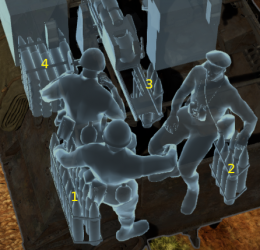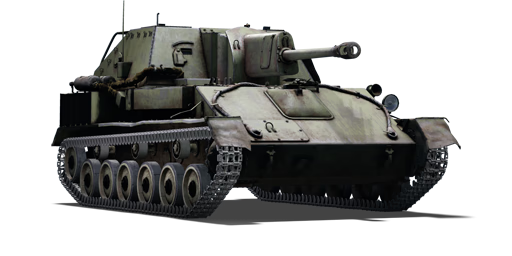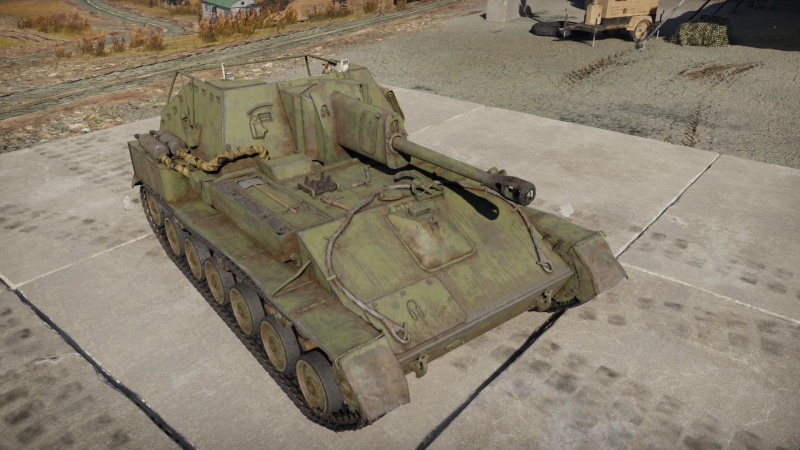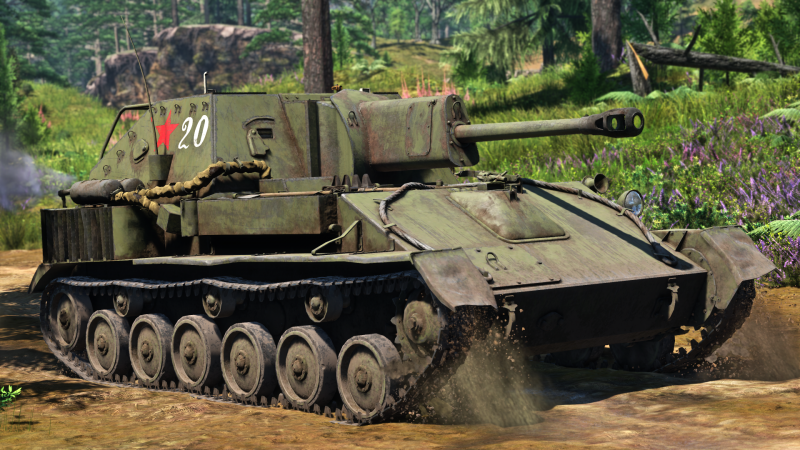SU-76M
| This page is about the Soviet tank destroyer SU-76M. For other versions, see SU-76M (Family). |
Contents
Description
The SU-76M is a rank I Soviet tank destroyer with a battle rating of 2.0 (AB/RB/SB). It was introduced during the Closed Beta Test for Ground Forces before Update 1.41. It is based on the modified chassis of the obsolescent T-70M light tank, designed primarily as an infantry support weapon with a secondary anti-tank role.
General info
Survivability and armour
The SU-76M shares a similar hull armour profile with the T-70 light tank on which it is based. The hull, with a large, well-angled 25 mm upper front plate, might bounce some shells when the hull is angled, but high-penetrating guns such as 5 cm KwK39 can still penetrate it easily. Once penetrated the driver will get knocked out, or the transmission/engine will be broken, immobilising the tank. On the back of the hull, the SU-76M has a lightly armoured open-topped superstructure to accommodate the 76 mm gun. With a maximum thickness of only 25 mm and poor angling, the superstructure will not stop much more than heavy machine gun fire. Common tanks such as Pz.II, M3A3, AB 41, etc are all able to penetrate the front of the fighting compartment with ease, and knock out any crew in the shell path. The crews are quite cramped together too, further decreasing the survivability against explosive-filled rounds. It is only able to resist rifle-calibre rounds or heavy machine gun fire from far away. The open-topped design also makes the SU-76M very vulnerable to aircraft strafing runs.
Armour type:
- Rolled homogeneous armour
| Armour | Front | Sides | Rear | Roof |
|---|---|---|---|---|
| Hull | 25 mm (60°) Front glacis 30 mm (30°) Lower glacis 25 mm (35-89°) Driver's hatch |
15 mm | 15 mm (1°) Top 15 mm (32°) Lower |
7 mm |
| Superstructure | 25 mm (27°) | 10 mm (21-24°) Left 10 mm (18-19°) Right |
15 mm (1°) | N/A |
Notes:
- Suspension wheels are 10 mm thick while tracks are 15 mm thick.
- Belly armour is 7 mm thick.
- The rear superstructure does not cover the entire crew compartment.
- A 25 mm plate of armour separates the driver's and engine compartment to the rear fighting compartment.
Mobility
| Game Mode | Max Speed (km/h) | Weight (tons) | Engine power (horsepower) | Power-to-weight ratio (hp/ton) | |||
|---|---|---|---|---|---|---|---|
| Forward | Reverse | Stock | Upgraded | Stock | Upgraded | ||
| Arcade | 34 | 6 | 10.5 | 199 | 267 | 18.95 | 25.43 |
| Realistic | 31 | 6 | 124 | 140 | 11.81 | 13.33 | |
The SU-76M has a very low top speed of only about 30 km/h, considering how lightly armoured it is. It also has a poor reverse speed of only 5 km/h. It does have a good power/weight ratio, however, and accelerates and turns fairly quickly.
Modifications and economy
Armaments
Main armament
| 76 mm ZIS-3 | Turret rotation speed (°/s) | Reloading rate (seconds) | |||||||||||
|---|---|---|---|---|---|---|---|---|---|---|---|---|---|
| Mode | Capacity | Vertical | Horizontal | Stabilizer | Stock | Upgraded | Full | Expert | Aced | Stock | Full | Expert | Aced |
| Arcade | 60 | -5°/+15° | ±15° | N/A | 6.2 | 8.5 | 10.4 | 11.4 | 12.2 | 7.80 | 6.90 | 6.36 | 6.00 |
| Realistic | 4.2 | 4.9 | 6.0 | 6.6 | 7.0 | ||||||||
The ZiS-3 field gun is a versatile artillery piece that is also capable of performing in the anti-tank role. It has a decent rate of fire and a wide traverse arc, but the mounting has very poor gun depression due to the rearward placement of the superstructure. It has a very wide-selection of ammunition, though only a few are worth using regularly.
Ammunition
The stock BR-350A APHEBC shell is adequate enough for most purposes, although it will struggle against heavy tanks like the Churchill at long ranges. The BR-350B APHEBC shell is arguably the best all-round projectile available, combining decent penetration with excellent lethality. Against particularly heavy armour, the BR-354P APCR shot is available, though its poor lethality and performance against sloped armour will tend to disappoint. The BR-350SP APBC shot is a solid shot round with no filler, but it creates more spalling than the APCR and is somewhat more lethal. The BP-353A HEAT round is occasionally useful for long-range fighting since it does not lose penetration with distance, but the Soviet 76 mm guns generally do not perform very well at long range, and work better at medium to close range. It also has some utility for breaking the hulls of lightly armoured vehicles, while not being completely useless against heavier opposition like the HE round. The Sh-354T shrapnel round creates a lot of fragments when it penetrates, but is only effective against lighter vehicles.
| Penetration statistics | |||||||
|---|---|---|---|---|---|---|---|
| Ammunition | Type of warhead |
Penetration @ 0° Angle of Attack (mm) | |||||
| 10 m | 100 m | 500 m | 1,000 m | 1,500 m | 2,000 m | ||
| BR-350A (MD-5 fuse) | APHEBC | 87 | 85 | 77 | 69 | 62 | 55 |
| BR-350SP | APBC | 99 | 96 | 87 | 76 | 66 | 58 |
| BR-354P | APCR | 125 | 117 | 87 | 60 | 41 | 28 |
| BP-353A | HEAT | 80 | 80 | 80 | 80 | 80 | 80 |
| BR-350B (MD-8 fuse) | APHEBC | 96 | 94 | 84 | 74 | 64 | 56 |
| OF-350M | HE | 10 | 10 | 10 | 10 | 10 | 10 |
| Sh-354T | Shrapnel | 35 | 34 | 30 | 26 | 22 | 19 |
| Shell details | ||||||||||||
|---|---|---|---|---|---|---|---|---|---|---|---|---|
| Ammunition | Type of warhead |
Velocity (m/s) |
Projectile mass (kg) |
Fuse delay (m) |
Fuse sensitivity (mm) |
Explosive mass (TNT equivalent) (g) |
Ricochet | |||||
| 0% | 50% | 100% | ||||||||||
| BR-350A (MD-5 fuse) | APHEBC | 662 | 6.3 | 1.2 | 14 | 150 | 48° | 63° | 71° | |||
| BR-350SP | APBC | 655 | 6.5 | - | - | - | 48° | 63° | 71° | |||
| BR-354P | APCR | 950 | 3.02 | - | - | - | 66° | 70° | 72° | |||
| BP-353A | HEAT | 355 | 3.94 | 0.05 | 0.1 | 600 | 62° | 69° | 73° | |||
| BR-350B (MD-8 fuse) | APHEBC | 655 | 6.5 | 0.9 | 14 | 100.1 | 48° | 63° | 71° | |||
| OF-350M | HE | 680 | 6.2 | 0.05 | 0.1 | 621 | 79° | 80° | 81° | |||
| Sh-354T | Shrapnel | 618 | 6.44 | 1.2 | 14 | 85 | 62° | 69° | 73° | |||
| Smoke shell characteristics | ||||||
|---|---|---|---|---|---|---|
| Ammunition | Velocity (m/s) |
Projectile mass (kg) |
Screen radius (m) |
Screen deploy time (s) |
Screen hold time (s) |
Explosive mass (TNT equivalent) (g) |
| D-350A | 680 | 6.45 | 13 | 5 | 20 | 50 |
Ammo racks

| Full ammo |
1st rack empty |
2nd rack empty |
3rd rack empty |
4th rack empty |
Visual discrepancy |
|---|---|---|---|---|---|
| 60 | 44 (+16) | 37 (+23) | 30 (+30) | 1 (+59) | No |
Usage in battles
The SU-76M offers an interesting alternative to the ZiS-30. While the ZiS-30 is more mobile and has substantially higher penetration with its powerful 57 mm gun, the SU-76M trades some mobility and penetration for a much more lethal gun and somewhat better survivability for the crew.
Like most turretless tank destroyers, the SU-76M needs to be handled with care. Not only does it not have a rotating turret, it is also lightly armoured, has an open top, and practically no protection from behind. The crew is quite exposed to air, artillery, and rear attacks, which can disable them with even machine gun fire. The frontal glacis is capable of bouncing autocannons or small anti-tank guns, but the superstructure is still quite vulnerable. In a full uptier, the vehicle effectively has no armour. If forced to take a hit, the front-mounted engine and internal armour plate can absorb shots if angled correctly, thus buying some extra time to get another shot off at the risk of losing the engine.
The SU-76M lacks the speed to perform daring flanking manoeuvres or quickly take control of key locations. Unlike the high penetration 57 mm ZiS-2 gun on the ZiS-30, the 76 mm ZiS-3 tends to struggle at long range against heavier armour such as that on the M4A1 and the Churchill Mk I.
However, it far outclasses the 57 mm gun in terms of lethality when using the APHEBC rounds, often taking out opponents in a single shot upon successful penetration. Furthermore, the poor gun depression and rearward placement of the gun restricts hull down opportunities using terrain. This combination of characteristics tends to favour more close/medium range, ambush-oriented playstyles. The wide gun traverse arc and relatively small profile are also very useful for this.
The SU-76M is particularly well-suited for setting up ambushes or flanking shots in urban combat, which tends to occur at short ranges and where the poor gun depression is less of an issue. The ready availability of hard cover also helps to offset the poor armour of the SU-76M, although its poor reverse speed is a distinct drawback. In more open maps, the SU-76M is very dependent on concealment using trees and bushes, as the armour is generally not reliable and the open crew compartment makes it a very common target for aircraft strafing runs if it is spotted.
Not only does it not have a rotating turret, it has an open top and practically no protection from behind. Therefore, when an engagement's complexity evolves and the Su-76 is surrounded, there is little that can be done to survive. One well placed hit to its rear will knock out a good part of the exposed crew, even machine guns can do the job of eliminating both loader and gunner.
It is crucial to remain at a distance from the enemy, perhaps even seek the cover of trees for protection against low-level attack aircraft, and to only ever give the front side to an enemy. The fact that this vehicle does not have a turret not only means that it is not effective when fighting more mobile enemies attempting to flank, it also means that placing the armour at an angle is not a viable strategy to increase relative armour thickness and stay more protected, since the gun's limits for horizontal traverse mean that any significant angle of the hull towards an enemy will make make it harder to keep the enemy in sight. What can be done is to fire a shot and, immediately after, angle the hull whilst reloading, to then return to facing the enemy to fire another shot. However, hiding whilst reloading is the most sensible choice.
Unfortunately, the SU-76 has low mobility, handling, and a vastly different gun when compared to its smaller and more mobile cousin, the ZiS-30. However, the gun on the SU-76 is definitely more powerful than the ZiS-30's 57 mm. The sheer force of the 76 mm shells will cause huge amounts of trauma to a target upon penetration. The SU-76 is also more well armoured than the ZiS-30 and provides much more protection to the gunner crew, especially from smaller calibre rounds (Unless fired from the rear). Given its poor gun depression and velocity, the SU-76 should be used as a mobile brawler and ambusher. It is well suited to performing ambushes in urban areas. The high HE filler of the 76 mm shell makes it capable of knocking out nearly all enemy armour at its BR with a single shot. A minor issue with the SU-76 is that it has no defensive machine gun, meaning that responding quickly to SPAA is difficult.
The gun in itself is what makes the SU-76M a good vehicle, all its other characteristics are less than impressive. The variety of ammunition is a definite pro for this SPG, its APCR and HEAT shells being effective even at higher ranks, giving this humble tank destroyer the ability to defeat higher-ranking tanks like the Tiger H1. Recently, the much more effective late-war BR-350B ammunition has been added to the SU-76M's ammunition options. It features noticeably more penetration and a better fuze in exchange for somewhat less explosive mass. Despite this, the SU-76M will often destroy most enemies in one shot when the shells penetrate. Once unlocked, the SU-76 is quite capable of dealing with any tank it is likely to see from the front, though there may be a need to swap ammunition often to deal with different targets.
Enemies worth noting:
M4A3 (105): This low-rank Sherman posts a huge threat to every of its opponents due to its superior armour and destructive firepower. Its armour is overall quite tough to penetrate with your short 76 mm gun, but it can be solved by careful aiming. If the M4 is within 200 m, use default APHE to shoot at the vertical part of its gun mantlet or its side if exposed. If it's hull down within 100 m, only target the gun mantlet with either APHE or APCR to disarm it. When the M4 is further than 400 m away, all of your shells will perform poorly at penetrating its armour, so disengage or wait until it gets closer. Remember to not get hit by it, its HE or HEAT is likely to knock the SU-76 out with ease.
Pros and cons
Pros:
- Decent horizontal gun traverse of 30 degrees
- Great cannon, its deadly APHEBC packs a heavy blow for common opponents like the Pz.IIIs, Crusaders and Stuarts
- Offers a wide range of ammo to deal with various opponents: APHEBC for normal targets, HE/shrapnel for soft targets and APCR for the hard ones
- Small profile makes it easy to hide and set up ambushes
- Adequate acceleration and hull traverse
- Carries up to 60 rounds of ammo which is plenty even for a long battle
Cons:
- Open-topped, very vulnerable to strafing aircraft.
- Thin armour struggles to protect the crew from even .50 cal
- -5 degrees of gun depression isn't enough for hill combat, and this flaw is sometimes fatal
- Lacks a machine gun, making it rather ineffective against vehicles with light armour/exposed crew, for example SPAAs
- Poor reverse speed of only 5 km/h might get the player killed
- Cannon penetrates poorly at more than 700 m. Will struggle to penetrate hard targets like the Matildas, Churchill Mk I or even the early Shermans
History
Development
During the interwar years, the development of self-propelled artillery was practically nonexistent in the Soviet Union. Those few projects, based on the chassis of T-26 light tank, such as SU-1, AT-1 or SU-26, were eventually cancelled, and the Red Army entered the Second World War entirely without a dedicated self-propelled gun.
The situation changed after the German invasion in 1941, and vehicles such as the SU-152 or SU-122, based on the KV-1 and T-34 tanks respectively, were developed. In November 1942, the State Defense Committee then ordered the production of a light self-propelled gun, built on the chassis of a light tank and armed with a 76.2 mm gun. The T-70 light tank chassis was chosen, as the other light tanks, the T-50 and T-60, was already out of production. The chassis had to be modified for this role, so it was lengthened and had one additional pair of road wheels added to the design. The armament, the 76.2 mm divisional M1942 gun (also designated ZiS-3), was mounted in a fully enclosed casemate. The gun was positioned at the rear, with the transmission being mounted frontally. The vehicle was designated SU-76 (Samokhodnaya Ustanovka, "Self-Propelled Gun"), and the production was issued to the No.38 Factory in Kirov and started in December 1942. However, after only a couple of hundred vehicles were produced, the production was halted due to serious mechanical problems and other issues. The power train consisted of two GAZ-202 automobile engines, with each powering one track. However, there was no synchronization gear, so the driver has to control both engines simultaneously, which was an extremely difficult task. This arrangement also caused strong vibrations, which were the cause of frequent engine and transmission failures. The second biggest issue was the enclosed crew compartment, as it was very cramped and offered only a little space for crew members to work properly. The vehicle thus had to be modified, firstly the roof of the crew compartment was removed, improving the access to the gun. The power train was also changed, receiving the more powerful GAZ-203 engines, each producing 85 horsepower, which was now mounted in tandem on the right side of the vehicle, propelling a single drive-shaft. The modified vehicle was designated SU-76M, and its production was resumed in early 1943. More than 14,000 SU-76M's were produced between 1942-1945, making it the second most produced armoured vehicle in the Soviet Union after the T-34 tank.
Combat usage
In its intended role, the SU-76M replaced earlier infantry support tanks and was very welcome to Soviet infantry units as it provided them with a light and mobile universal support weapon. The vehicle was meant to be part of three battlefield roles - a light assault gun, a mobile tank destroyer, or a mobile artillery gun as the weapon could be fired indirectly at a range of 17 km. The vehicle was fairly lightweight and produced low ground pressure, enabling it to pass through terrain unsuitable for heavier vehicles. Its gun could utilize a multitude of ammunition types, aside from standard high explosive ammunition, it could use fragmentation, shrapnel, incendiary and smoke rounds. As a tank destroyer, the gun was sufficient against German light and medium tanks such as Panzer III or Panzer IV. The introduction of the APCR and HEAT rounds then enabled SU-76M units to engage even heavier Panther and Tiger tanks with some success, though crew manuals instructed the gunner to try to hit the tracks or gun barrels before these rounds were made.
The vehicle also proved itself effective in an urban environment, where it was used as an assault gun for direct fire against enemy strong points and fortifications. The open-topped casemate made the crew vulnerable to snipers and hand grenades, but it also made the communication between vehicle commander and any accompanying infantry easier. Plus, it was found that the open compartment actually helps against the German infantry anti-tank weapon Panzerfaust, where a closed space would ensure the death of the crew members from the blast concussion amplified in the closed space. The SU-76M's low ground pressure from its weight made it one of the only Soviet vehicles able to operate in swampy terrain, which was extremely helpful during the Belarus Campaign in 1944, allowing the vehicle to attack through swamps in raids. This allowed the Soviets to bypass German defensive areas on more suitable terrain with support of an assault gun accompanying the light infantry. One famous SU-76M user was Rem Nikolaevich Ulanov, who was famous World War II veteran and his crew called their SU-76 the "Columbina".
After the end of World War II, the SU-76M was phased out of production, but many of them were exported to other countries, such as China, Cuba, North Korea, North Vietnam or Czechoslovakia, where they would be used in conflicts such as the Korean and Vietnam War against the US and their allies.
Survivors
Due to the large quantity produced and usage after World War II, many are found in intact conditions today in various locations around the world. Some could even be found as war monuments for the Soviet and German memorials.
| Archive of the in-game description | |
|---|---|
|
The SU-76M was created based on the T-70M light tank as a mobile infantry escort. In the front of the vehicle, the driver was seated on the left and the engine compartment was on the right. The fighting compartment was in the rear of the vehicle, in a cabin open at the top and partially open at the rear. The vehicle's crew consisted of 4 people. The vehicle's commander and loader sat on the right of the armoured cabin, and the gunner sat to the left of the cannon. The SPG was armed with a 76.2 mm ZiS-3 cannon. Placing the cannon in an armoured cabin simplified the production of these SPGs in comparison to manufacturing tanks, and allowed for them to be produced in a higher overall quantity. In 1944, when armoured vehicle production in the Soviet Union reached its height, around 25% of the overall number of full-track combat vehicles manufactured were SU-76Ms. The No. 38, No. 40 and GAZ factories mass-produced these vehicles. By 1945, these factories had produced 13,932 SU-76Ms in total. Consequently, the SU-76M became the most prolific Soviet SPG in World War II. Vehicles of this type were widely used in combat operations both as infantry support vehicles and as tank destroyers against enemy light tanks, medium tanks and SPGs. With different types of ammunition at hand, they were able to overwhelm infantry, artillery and armoured targets alike. A subcalibre round from the vehicle could penetrate 100 mm armour from a distance of 500 metres. These SPGs gained an excellent reputation in battle. As a vehicle of its class, the SU-76M was practically equal in all regards to its foreign counterparts. After the war, the vehicles served in the Soviet Army until the beginning of the 50s, and in the DPRK army throughout the 50s. | |
Media
- Skins
- Videos
See also
- Other vehicles of similar configuration and role
External links
- [Vehicle Profile] SU-76
- [Wikipedia] SU-76
- [Tanks Encyclopedia] SU-76
- [Military Factory] Su-76 (Suchka)
| Gorky Automobile Plant (Го́рьковский автомоби́льный заво́д) | |
|---|---|
| SPAA | GAZ-AAA (4M) · GAZ-AAA (DShK) · GAZ-MM (72-K) |
| ZUT-37 · ZSU-37 | |
| Light Tank | T-60 · T-70 · T-80 |
| Tank Destoyer | SU-76M · SU-76M (5th Gv.Kav.Corps) · SU-85A |
| ZiS-30 | |
| Rocket | BM-8-24 |
| USSR tank destroyers | |
|---|---|
| SU-76M | SU-76M · SU-76M (5th Gv.Kav.Corps) · SU-85A |
| SU-57B | SU-57B · SU-76D |
| T-34 Derivatives | SU-122 · SU-85 · SU-85M · SU-100 · SU-122P |
| Heavy Tank Derivatives | SU-100Y · ISU-122 · ISU-122S · SU-152 · ISU-152 · Object 268 |
| SU-100P and Derivatives | SU-100P · Object 120 |
| Wheeled | YaG-10 (29-K) |
| Airborne | ASU-57 · ASU-85 |
| Rocket | BM-8-24 · BM-13N · BM-31-12 |
| ATGM | IT-1 · Shturm-S · Khrizantema-S |
| Artillery | 2S1 · 2S3M |
| Other | SU-5-1 · ZiS-30 · SU-122-54 · Object 775 |
| USA | SU-57 |






